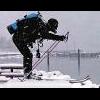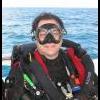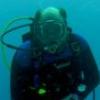EPIRB, Where can I compare and get one?
#1
 Guest_PlatypusMan_*
Guest_PlatypusMan_*
Posted 11 June 2009 - 02:54 PM
I'm considering obtaining one, but would like to know the plus and minus of the devices--and most importantly, how to compare between manufacturers offerings.
PPM
#2

Posted 11 June 2009 - 04:23 PM
Once in a while, it is good to step back, take a breath, and remember to be humble. You'll never know it all - ScubaDadMiami. If you aren't afraid of dying, there is nothing you can't achieve - Lao-tzu. One dog barks at something, the rest bark at him - Chinese Proverb.
#3

Posted 11 June 2009 - 05:08 PM
This EPRIB is small enough to be placed in a waterproof and PRESSURE proof container and carry below to REC diving depths.
ACR Electronics is a large provider of marine safety equipment. The link above will take you to the latest & greatest personel size EPRIB or check out http://www.westmarin...catalogId=10001 that carries same line. West Marine is a large boating supplier that you maybe able to find in inland cities. They have moved most of thier EPBIB to the online catagog.
Good luck, Ss
#4

Posted 11 June 2009 - 08:43 PM
"For the diligent diver, closed circuit rebreathers are actually safer than open circuit scuba." Tom Mount
#5

Posted 11 June 2009 - 09:04 PM
http://www.acrelectr...px?sku=2797.4NH
...
ACR Electronics is a large provider of marine safety equipment...
Proceedings Magazine >> "One fact supporting international SAR engagement is that U.S. citizens by the millions travel around the globe. Our citizens have come to expect U.S. government support to some extent when they get into a crisis away from home. We need to manage these expectations."
Proceedings, Search and Rescue Engagement, by Mr. David L. Edwards, USCG Office of Search and Rescue, pg. 50, "What's in it for Us?"
View "Proceedings" online at http://www.uscg.mil/proceedings/
Responsible Use...
The [Personal EPIRB] is a satellite signaling device of last resort, for use when all other means of self rescue have been exhausted, where the situation is grave, and imminent loss of life, limb, eyesight, or valuable property will occur without assistance.
http://www.acrelectronics.com/product2.aspx?sku=2797.4NH
My opinion and perspective is from my North American orientation and is completely unofficial. United States Code prevails, obviously, in the USA. EPIRB devices sold in the USA are FCC regulated. If you have a Class B EPIRB, you will want to consider an "upgrade" to the newer Category I or Category II as described below. However, other countries may still use Class B EPIRB. What the United States Federal Communication Commission (FCC) is calling Category I and Category II EPIRB units, should operate in areas that still use older equipment. Since these are the newest thing in EPRIB, an official Rescue Coordination Center will eventually receive the EPRIB signal. At least one source of information reports it may take an hour for an RCC to receive the signal from satellite and narrow the search area.
Does Germany use Class B EPIRB?
Please let me know what you choose. And if you find ANY rated recreational dive gear, post it for all of us, please.
EPIRB information:
SAR Facts, Reports, Presentations & Info Sheets
http://www.uscg.mil/hq/cg5/cg534/SAR_facts_reports.asp
ANSI
The American National Standards Institute. "An official body within the United States delegated with the responsibility of defining standards."
ISEA
International Safety Equipment Association. "The trade association in the United States for companies that manufacture safety and personal protective equipment. Its member companies are world leaders in the design and manufacture of protective clothing and equipment used in factories, construction sites, hospitals and clinics, farms, schools, laboratories, emergency response and in the home."
ANSI/ISEA 107-2004
"This is the culmination of several years of work by the ISEA High Visibility Products Group, in cooperation with employers and workers, test labs and material suppliers, safety professionals, and federal, state and local authorities."
NIOSH
"National Institute for Occupational Safety and Health. The federal agency responsible for conducting research and making recommendations for the prevention of work-related injury and illness."
http://www.cdc.gov/niosh/about.html
Types of EPIRBs
Emergency position indicating radiobeacons (EPIRBs), devices which cost from $200 to about $1500, are designed to save your life if you get into trouble by alerting rescue authorities and indicating your location. EPIRB types are described below:
Class A
121.5/243 MHZ. Float-free, automatically-activating, detectable by aircraft. Coverage is limited. These devices have been phased out by the FCC and may no longer be used, marketed or sold in the U.S..
Class B
121.5/243 MHZ. Manually activated version of Class A. These devices have been phased out by the FCC and except for certain devices used as personal locator beacons, may no longer be used, marketed or sold in the U.S..
Class C
VHF ch15/16. Manually activated, operates on maritime channels only. These devices have long been phased out by the FCC and may no longer be used, marketed or sold in the U.S..
Class S
121.5/243 MHZ. Similar to Class B, except it floats, or is an integral part of a survival craft. These devices have been phased out by the FCC and may no longer be used, marketed or sold in the U.S..
Category I
406/121.5 MHZ. Float-free, automatically activated EPIRB. Detectable by satellite anywhere in the world. Recognized by GMDSS.
Category II
406/121.5 MHZ. Similar to Category I, except is manually activated. Some models are also water activated. Inmarsat E 1646 MHZ. Float-free, automatically activated EPIRB. Detectable by Inmarsat geostationary satellite. Recognized by GMDSS. These devices have been phased out by Inmarsat.
Radio Signal Degredation/Availability/Interference Threats
GPS Interference By Solar Radio Bursts
"Solar interference to GPS downlink signals appears to be a possibility during the lock acquisition phase, but the probability is very low, and is expected to occur only a few times in each solar cycle (around 11 years in duration) and only for a few minutes on each occasion."
http://www.ips.gov.au/Educational/1/3/10
"Global Positioning System satellites operate at 1.5 GHz. GPS signals are affected when solar storm causes sudden variations in the density of the ionosphere, causing the GPS signals to scintillate. Solar storms can add small delays from the GPS satellite signals impacting accuracy. Solar storms will cause signal fades that will make it difficult to gain and maintain satellite signal locks." ~ James A. Marusek (this quote is not from a .mil, .gov. or .edu site)
U.S. Policy Statement Regarding Civil GPS Availability
"The U.S. Government also maintains the capability to prevent hostile use of GPS and its augmentations while retaining a military advantage in a theater of operations without disrupting or degrading civilian uses outside the theater of operations." ~ (This site is hosted by NOAA)
http://pnt.gov/public/sa/sa.shtml
MIL-SPEC
Wakemaker's definitions of MilSpec(s) are military specifications as defined in official military documents for their United States Defense Standard parts requirements. MilSpec may also infer quality precision in the parts design which can be to the thousandths of an inch or state operational requirements such as temperatures and pressure.
http://www.dscc.dla.mil/Programs/MilSpec/d...asp?DocTYPE=MIL
RTCM
Radio Technical Commission for Maritime Services. In the United States, the Federal Communications Commission and U.S. Coast Guard use RTCM standards to specify radar systems, Emergency Position Indicating Radio Beacons, and the basic version of Digital Selective Calling radios. Personal Locator Beacons used on land in the U.S. are required to meet an RTCM standard.
http://www.rtcm.org/
121.5/243 MHz EPIRBs
Cospas-Sarsat Phase-Out of 121.5/243 MHz Alerting Services
"The International Cospas-Sarsat System has ceased satellite processing of 121.5/243 MHz beacons on 1 February 2009. All beacon owners and users should replace their 121.5/243 MHz beacons with 406 MHz beacons as soon as possible.
"Only 406 MHz beacons are now detected by the Cospas-Sarsat satellite system..."
See Switch to 406! http://www.cospas-sarsat.org/firstpage/121.5phaseout.htm
The International Cospas-Sarsat System ceased satellite processing of 121.5/243 MHz beacons on 1 February 2009. Although Emergency Locator Transmitters used by aircraft may still be used, alerts from these devices or from 121.5/243 MHz EPIRBs will no longer be acted upon unless detected by an overflying aircraft.
www.navcen.uscg.gov/marcomms/gmdss/epirb.htm
SOLAS
The International Convention for the Safety of Life at Sea
http://www.imo.org/T..._...&doc_id=647
NMEA
The National Marine Electronics Association. "The National Marine Electronics Association (NMEA) is the unifying force behind the entire marine electronics industry, bringing together all aspects of the industry for the betterment of all in our business."
http://www.nmea.org/
GMDSS
Global Maritime Distress & Safety System
http://www.navcen.us...dss/default.htm
Survival device purchase decision tree.
Looks like we will have to generate this ourselves. And there seems to be no SCUBA diver specific emergency/distress transmiter/receiver for recreational divers. The CFR requires PLBs only need to operate for 24 hours. A wet suit may not sustain an immursed diver for that length of time. Our BCDs are also not rated as "life jackets." Survival is about rescue, not a body recovery. A medical emergency when you are IN THE WATER might justify use of an EPIRB.
Only You Can Prevent False Alarms
"By doing so, you will increase the effectiveness of the very system your life may someday rely on!"
http://www.sarsat.noaa.gov/false.html
Beacon registration
In the U.S., users are required by law to directly register their beacon in the U.S. 406 MHz Beacon Registration Database at: http://www.beaconregistration.noaa.gov/ or http://www.sarsat.noaa.gov/beacon.html or by calling 1-888-212-SAVE. Other users can register their beacon in their country's national beacon registration database or, if no national database is available, log onto in the International Beacon Registration Database at https://www.406registration.com/. Fax the signed form to NOAA at 301-568-8649 or put the form in an envelope and mail it to the SARSAT Beacon Registration regular mail address found on the FCC link below. Important: NOAA's beacon registration database only accepts registration applications to include the country codes of: Alaska (303), Hawaii (338), Puerto Rico (358), US Virgin Islands (379), Northern Marianas Isands (536), American Samoa (559), and the contiguous United States (366, 367, 368, & 369). If you do not have a beacon coded for these areas you cannot register your beacon with NOAA. Contact your beacon manufacturer to see where to register your beacon if you own a non-U.S.A. coded beacon.
FCC > WTB > Services > PLB Home
http://wireless.fcc....ersonal_locator
CFR Service Rules
Personal Locator Beacon > CFR, Part 95.1400-95.1402
General Mobile Radio Service (GMRS)
The FCC grants five-year renewable licenses for GMRS Systems. The individual licensee is responsible for the proper operations of the licensed GMRS system at all times. (I have noted some GMRS handie-talkies will provide two-way communication well over 10 miles depending upon the conditions and relative situation of the radios. It might be safe to say, that if you can hit the reciving radio with your flashlight beam, you can confer with that station. If you are in the water, and your dive boat is small, and bouncing around in the waves, you might not be able to see it (or contact it by VHF or UHF radio) once you get a little too much distance -- reference term; height of eye)
Family Radio Servoce (FRS)
Family Radio Service (FRS) is one of the Citizens Band Radio Services. It is used by family, friends and associates to communicate within a neighborhood and while on group outings and has a communications range of less than one mile. You may use your FRS unit for business-related communications.
Satellite Phones (unable to locate ruggedized models)
Global Star (services from most of the planet, North and South of the equator)
Iridium (services the entire planet, including the North and South poles)
Satellite Phones (ruggedized models)
Various "waterproof" models available (searching for specs)
JIS
JIS stands for Japanese Industrial Standards.
Next Generation Distress and Emergency Search & Rescue System
I got word the USA is building a new type of SAR system ground station which is either being built or will be completed in 2009 or 2010. Will it obsolete the current SAR system or augment?
Emergency Signaling Device Rental Sources
Got a clue?
INMARSAT
International Maritime Satellite Organization Inmarsat owns and operates a global satellite network and offers mobile satellite communications services for users in the maritime, land and aeronautical sectors.
Inmarsat will withdraw EPIRB service in 2006 and promises new safety service on next generation I-4 satellites.
http://www.inmarsat....s/00021497.aspx
COSPAS
Space System for Search of Distress Vessels (a Russian acronym)
LEOSAR (Low Earth Orbiting)
Completes an orbit about every 1-1/2 hours or so. These are the only satellites that cover the poles (right?); polar orbiting satellites.
GEOSAR
A system which consists of GOES weather satellites and other geostationary satellites. "Note that GEOSAR cannot detect 121.5 MHz alerts, nor can it route unregistered 406 MHz alerts to a rescue authority. GEOSAR cannot calculate the location of any alert it receives, unless the beacon has an integral GPS receiver." (Need to confirm geostationary, geosynchronous orbits.)
GEOSTAR
May be synomous with GEOSAR
SARSAT
Search and Rescue Satellite-Aided Tracking
FCC Licenses
An FCC ship station license is no longer required to purchase or carry an EPIRB.
The pic attached
Article, US Coast Guard, What is the NSARC? (The National Search and Rescue Committee)
http://www.uscg.mil/...ncy_Beacons.asp
Reset (changing a MMSI number)
If you purchase a used HX470x, by Standard Horizon, as an example, you will have to send it to the manufacturer for service in order to reset the MMSI number after the second time. Ham Radio Outlet (HRO) provide these parcel services for me.
Case:
Request for Waiver of Part 80 Rules to Allow > Certification and Use of Personal/Vessel Radar > Beacon Transponders
http://www.fcc.gov/Daily_Releases/Daily_Business/2009/db0310/DA-09-562A1.txt
Discarded EPIRB triggers a $5,500 fine. Tossed into the Pacific, the beacon did its job, touching off a $35,000 Coast Guard search. Posted on April 28, 2009. Written by Elizabeth Ellis.
http://www.soundingsonline.com/news/coastwise/234428-discarded-epirb-triggers-a-5500-fine.html
=======
The following two paragraphs are quoted from Cruising World Magazine, www.cruisingworld.com, November 2008, SAFETY AT SEA, by Duncan Raymond, "A Successful Rescue on the High Seas, pg 71, (text box)
Numbers to Take Offshore
These are the numbers for the U.S. Coast Guard's Rescue Coordination Centers and Rescue Subcenters, the 911s of the sea. The Coast Guard still monitors VHF Channel 16, as do many of the ships at sea, but a VHF radio's signal is limited to the line of sight, antenna to antenna. Shortwave is variably reliable, due to interference from sun spots and the vagaries of individual installations. The vulnerabilities of a satellite phone are that you might not have the number available when you need it and, as in the case of our portable phone, which we needed to take on deck to make a call, it can become wet or damaged.
In this list of U.S. Coast Guard emergency numbers, the Atlantic Search-and-Rescue Coordinator has overall responsibility for the U.S. East Coast out to 40 degrees west; the Pacific SAR Coordinator has overall responsibility for the U.S. West Coast. For additional information on U.S. Coast Guard Search and Rescue, visit the website...
http://www.uscg.mil/top/news/phonebook.pdf
Phone numbers change so I've included a link to the current directory rather than post numbers that may evenually expire. Message me if you want to clarify any number. I'm not sure I understand why we aren't directed to call the "800 number" from a satellite phone. One other thing to consider when choosing a satellite phone is the minimum area of coverage. Iridium is the ONLY hand held satellite phone that provides global coverage. Global Star does not cover the poles.
=======
International partners in global rescue responses:
The World Factbook provides information on the history, people, government, economy, geography, communications, transportation, military, and transnational issues for 266 world entities.
https://www.cia.gov/library/publications/the-world-factbook/
("266 world entities?" What are they talking about?)
First world countries ("What are you talking about?" I like the definition of, "well defined countries" rather than strict monetary rankings). These are some countries and their adjacent areas that should be compatible with Category I and Category II units (as per FCC regulations mentioned above) which MAY be able to provide an appropriate response to an EPIRB activation.
AMSA
Australian Maritime Safety Authority is responsible for search and rescue around Australia. The operations centre is known as the Rescue Coordination Centre or RCC Australia and is located in Canberra. "In or near Australia, an activated EPIRB or PLB will relay a message to the search and rescue coordination centre in Canberra."
http://www.amsa.gov....rch_and_rescue/
Canada
The Joint Rescue Coordination Centre (JRCC) Halifax is responsible for the coordination of all Search and Rescue (SAR) operations associated with aircraft and marine emergencies in eastern Canada.
http://www.jrcchalifax.forces.gc.ca/
Turkey
http://www.reliefweb..._Turkey_35.html
INSARAG
International Search and Rescue Advisory Group
This URL is probably under direction of the United Nations Office for the Coordination of Humanitarian Affairs. Since I am trying to point to Turkey, I dropped this under the First World list.
http://www.reliefweb..._Turkey_35.html
United Nations Office for the Coordination of Humanitarian Affairs
Office D608
Palais des Nations
8-14 ave de la Paix
1211 Geneve 10 GE
CH
+41.229172184
http://www.reliefweb.int/
The United States of America
The Coast Guard is the Maritime SAR Coordinator. To meet this responsibility, the Coast Guard maintains SAR facilities on the East, West and Gulf coasts; in Alaska, Hawaii, Guam, and Puerto Rico, as well as on the Great Lakes and inland U.S. waterways.
http://www.uscg.mil/hq/cg5/cg534/
Second world countries ("What are you talking about?" Makes sense to me because of the ASEAN markets. Many parts of the world have physical borders with incompatible governments. Once an EPIRB activation bulletin goes out over the air waves, a ship 1300 feet long may respond -- if they can see your signal. Their lookouts are on the bridge wings, 50 feet above the water. The bridge crew might spot your VDS, visual distress signal, from 10 miles away!) A commercial jet might confirm your EPIRB signal. But at 600 mph, and 40,000 feet high, I'm not going to bet they'll see your emergency strobe light.
Hong Kong Maritime Rescue Coordination Centre
Hong Kong MRCC maintains very good working relationships with other rescue centres in the region. These centres include the Guangdong RCC, Beijing RCC, Taipei RCC, Ho Chi Minh RCC, Japan Coast Guard, Philippine Coast Guard, and the USA Coast Guard.
http://www.mardep.gov.hk/en/publication/pressrel/pr2k1017m.html
Third world countries ("What are you talking about?" Countries that, um, like might not have a government... maybe?)
South African Search and Rescue Services
In January 2007, a multilateral agreement was formally signed between the Governments of the Comoros, Madagascar, Mozambique and South Africa for the coordination of maritime search and rescue services in areas adjacent to the coast. (Ref. SAMSA; South African Maritime Safety Authority)
http://www.samsa.org.za/content.asp?subID=8
Regional Maritime Rescue Coordination Centre, Monrovia, Liberia
The establishment of appropriate SAR facilities off the coast of Africa was seen as a key component in the implementation of the Global SAR Plan, the final part of which had been agreed in 1998 at an IMO Conference in Fremantle, Australia and, within which, Liberia had formally agreed to undertake responsibility for the coordination and control of SAR operations across a substantial sea area exceeding her obligation under the SOLAS Convention to do so in areas around her coast.
http://www.imo.org/About/mainframe.asp?topic_id=1773&doc_id=11296
Fourth world countries ("What are you talking about?" It gets fuzzy from here. Will you get an appropriate response to an EPIRB activation? Got any input on this?)
Governments at that Conference agreed that a regional approach to the provision of SAR services in western, southern and eastern parts of Africa should be pursued and, to that effect, they adopted a resolution inviting the African countries bordering the Atlantic and Indian Ocean, anti-clockwise from Morocco to Somalia, as well as the nearby Atlantic and Indian Ocean Island States, to establish five regional centres and 26 sub-centres to cover their entire coastline areas for SAR coordination purposes.
Fifth world countries ("What are you talking about?" Is this where pre-industrial societies get grouped? What are reasonable expectations for rescue and medical attention. What are the risks associated when "help" arrives. EPRIB; a techologically advanced device used in a place that may not have helicopters, telephones, police, OSHA...)
Sixth world countries ("What are you talking about?") If you have access to published BEM facts, I could use your help here. Otherwise, I can check the CIA's site to see if they have a list.
Edited by Wakemaker, 17 September 2009 - 09:13 PM.
#6

Posted 12 June 2009 - 09:41 AM
#7

Posted 13 June 2009 - 08:49 AM
I also own a SPOT which isn't technically a PLB, but has an ability to send an emergency signal with GPS info as well as the ability to allow others to track where you are and for you to send very very simple preset messages to them. For emergency use, I'd prefer the PLB, since it has global coverage, has guaranteed battery life, transmits a local homing signal for rescuers in addition to what it sends to the satellites, and isn't one step removed from the Search & Rescue process, but SPOT may fill some people's needs.
And as was said earlier, it's a PLB you want, not EPIRB. I believe EPIRBs need to be registered to a specific boat, and that boat's information will pop up in the SARSAT center when activated. With a PLB, your personal information will pop up, and they'll make some calls to the contacts you give them when registering to make sure it isn't a false alarm.
#8

Posted 15 June 2009 - 08:02 PM
I do have a PLB - West Wind Fastfind with GPS.I think Capn Jack has one!
I think the comments are valid - and I have to add - you almost can't carry too much stuff if you think there is a likelihood of being separated from your boat and require a search & rescue effort.
They are expensive ($500 or so USD) - and the one I have has a canister (another 3) that lets me take it to depth (it doesn't help if it's on the boat).
Personally, if you visit some of the more remote locations, especially 3rd world - I think they are a good investment. You have to consider we're talking probably low double digit occurrences of lost divers splashing around on the surface out of the millions of dives and weigh against the cost. I think if you decide, you should definitely spend a little more for one with GPS integrated since it fixes your position faster, and much more accurately.
I will also say from personal experience in searching for people in the water, if this worst-case scenario happens, you want every edge you can get - people are incredibly hard to spot in any kind of sea state.
There was a thread somewhere about surface survival - and if you go the route of investing in this - you should also pick through that list since you're going to be waiting several hours regardless of what kind of device you have, given the event actually happens.
It might be enlightening to ask NOAA how many people are recovered annually because of them. My bet is very damn few, and even fewer divers - I can' t recall every seeing anyone else haul one around.
I think my main motivation was knowing how hard it is to find someone, and the knowledge I planned to hit several remote spots with lots of current and not much land nearby.
Jacques Yves Cousteau
#9

Posted 16 June 2009 - 12:05 AM
In practice this usually means that you will need to carry a device supplied by the boat, while they have installed on board the appropriate receiver. If you intend diving somewhere where losing contact with the boat is a real risk, choose one with the equipment.
#10

Posted 16 June 2009 - 01:40 AM
Around 15 years ago, I read an article that remarked about how safe SCUBA was, based on the number of actual dives per year. As I recall (that's a warning) it was something like 3,000,000 to 1 on a global basis; recreational diving was a safe sport. Where are the new figures?...It might be enlightening to ask NOAA how many people are recovered annually because of them. My bet is very damn few, and even fewer divers - I can' t recall every seeing anyone else haul one around...
During a seminar at the SCUBAshow.com 2009 event, Why Divers Die - Panel Discussion (with a panel of at least 3 people, one of which may have been Lieutenant John Kades, Los Angeles County Coroner's Office) and The Catalina Surge - Review of the Diving Accidents seen at the USC Catalina Hyperbaric Chamber (by Karl Huggins), lots of numbers and graphs were used. The method for activating a rescue alert for a SCUBA diver in distress was not discussed for each incident (especially for a person actually on a dive). There was at least some mention of a dive boat, underway, contacting emergency medical services.
Some (possible, "most") of California's diver problems are due to non-diving medical issues, while on a dive. They did not have and could not provide any statistics for how many dives were represented by each group of divers, or what dive equipment was used by each group. I don't even think there was a representation of types of environment/conditions or SCUBA gear configuration groups. All groups seemed to have problems. I don't know why they chose to define the groups as they did. With millions and millions of distress signaling devices in use, I would venture to guess VERY few are owned by divers.
Edited by Wakemaker, 16 June 2009 - 03:57 AM.
#11

Posted 16 June 2009 - 10:23 AM
I don't think I made myself clear. IMO any electronic beacon is only of any practical value if the boat you are diving from knows you have it and is monitoring for the signal (and of course has the appropriate equipment). Transmitting your GPS coordinates is all very well, but you may find the only people able to detect it are on an airliner passing by, while your dive boat maybe a mile away can't detect your signal.
I don't believe this is true. PLBs/EPIRBs/ELTs aren't transmitting to a local receiver, they're transmitting to the Cospas-Sarsat set of satellites. The signal is relayed by the satellites to a ground station which relays the information to the appropriate SAR (Search and Rescue) organization in the appropriate country. The process looks like this:

A big chunk of the earth is covered by geostationary SAR satellites that will pick up the signal almost immediately, the rest of the earth is covered by Low Earth Orbit (LEO) sats. If your beacon is a 406Mhz model (which basically every new one is, since the satellites stopped monitoring 121.5Mhz in Feb), they usually come either with a GPS built in, or not. With a GPS, the beacon sends it's identification string and your lat/long up to the satellites, where it gets relayed back to the local SAR agency. They generally also transmit a signal meant to be picked up locally so that they can home in on you once in the general area. Units without GPSes only transmit their identity to the satellites. The geostationary satellites know who triggered it, but not with any accuracy where. For a better location, they have to wait for one of the LEOsats to pass overhead and use doppler shift to establish your location. Given there isn't a huge price difference, a GPS unit is a better investment. The position SAR teams have to work with is within 1-3 nautical miles if determined via doppler, or around 100 yards with transmitted GPS.
Here's the coverage area of the geostationary SARsats:

As you can see, most areas are covered by multiple geosats as well as the leosats that covered the entire earth in their orbits.
Like I said, I would probably wait a while before triggering the beacon if I wasn't in immediate danger to give the boat a chance to find me, since triggering the beacon starts a major chain of events rolling, but I believe if I triggered the beacon, I would be rescued relatively quickly, depending on the resources of the local SAR agency (and local conditions).
#12

Posted 16 June 2009 - 10:34 AM
It might be enlightening to ask NOAA how many people are recovered annually because of them. My bet is very damn few, and even fewer divers - I can' t recall every seeing anyone else haul one around.
Here are some US stats from http://www.sarsat.noaa.gov/
COSPAS-SARSAT Rescues as of:
May 22, 2009
Number of Persons Rescued (To Date) in the United States: 54
- Rescues at sea: 42 people rescued in 20 incidents
- Aviation rescues: 1 person rescued in 1 incident
- PLB rescues: 11 people rescued in 11 incidents
· Worldwide – Over 24,500+ People Rescued (since 1982)
· United States – 6,093 People Rescued (since 1982)
Total Rescues in 2008: 282
- Rescues at sea: 202 people rescued in 65 incidents
- Aviation rescues: 12 people rescued in 7 incidents
- PLB rescues: 68 people rescued in 35 incidents
Here's one diver related SARSAT rescue, but not diver activated:
On 09 April 2005, the COSPAS-SARSAT system detected a 406 distress signal in position 27 27 N, 082 55 W. The operator of the F/V Sea Drive manually activated their 406 MHz EPIRB when they lost the location of one of their divers in the water. CGD7 RCC launched a HH-60 helicopter and a Coast Guard utility boat to the area. The utility boat arrived on scene and spotted a strobe light 9 NM SW of Tampa Bay, FL. The diver was found safe without any injuries and returned to his vessel. The Coast Guard helicopter was stood down before arriving on scene. One SARSAT Rescue.
#13

Posted 16 June 2009 - 03:21 PM
I don't think I made myself clear. IMO any electronic beacon is only of any practical value if the boat you are diving from knows you have it and is monitoring for the signal (and of course has the appropriate equipment). Transmitting your GPS coordinates is all very well, but you may find the only people able to detect it are on an airliner passing by, while your dive boat maybe a mile away can't detect your signal.
I don't believe this is true. PLBs/EPIRBs/ELTs aren't transmitting to a local receiver, they're transmitting to the Cospas-Sarsat set of satellites. The signal is relayed by the satellites to a ground station which relays the information to the appropriate SAR (Search and Rescue) organization in the appropriate country.
If we were all sitting around drink'n whisky at an SD HH, we could all be right! Actually, this is all about sharing information.
"Uninspected vessels" are not required monitor monitor radio or RADAR (if you have a marine radio and/or RADAR then you'd better have it on Channel 16/9 and have the RADAR set properly). This includes dive boats to big ocean going tugs and other vessels.
VECTA2 121.5 / 243 MHz Direction Finder
http://www.oceansafe...IRBS-Vecta.html
EPIRB or PLB that are programmable are falling into disuse. I'm pretty sure they are still for sale out side the US. Current, mainstream units may or may not transmit GPS coordinates. Rather, satellites and ground stations rely on doppler shift to get an accurate fix on an activated unit. That's where the 406 Mhz frequency does it's job.
SART, Search And Rescue (RADAR) Transponders work automatically with a receiving vessel's RADAR. We're on an "uninspected" commercial vessel. We have not a single piece of equipment that will automatically indicate a signal from a 406 Mhz / 121.5 Mhz distress signal. SART will show on the RADAR. Radar is in the 9 GHz range. Digital Selective Calling (DSC) radios may automatically switch-and-monitor Channel 70 when a DSC distress signal is received. Never interrupt USCG activity on any emergency channel. Monitor the channel traffic. You might be able to relay messages not heard by the other party.
Fordan posted a clear presentation of how an EPIRB or PLB signal might be processed. Rescue resources for people in the ocean or on cliffs are limited. Many of these vehicles/SAR units have other duties. False alarms disrupt the regular duties and generates dangerous situations and missed opportunities for Homeland Security. Take a good look at that pic. It illustrates why a good EPIRB or PLB or any other professional grade distress signaling electronic devices cost so much and must be controlled by the owner at all times. EPIRB devices are on the largest container ships and liquid natural gas tankers, and used by fishing vessels (The Perfect Storm, The Guardian movies), and would have saved the lives of football players who flip their boat. Do not allow your unit to interfere by sending false alarms.
I'm confused about the EPIRB, PLB and ELT descriptions for frequency uses. 406 MHz is the satellite frequency. It cuts through the upper atmosphere. 243 MHz is former US military version of the civilian 121.5 MHz frequency, used for homing. I've been noticing many referenes to 121.5 MHz being a satellite frequency. 121.5 can refract in the atmosphere, and ducting can occur. If it really was used by satellites, then that may be a reason it is no longer.
Revisions to this post:
* 2009JUN25 "Although these EPIRBs also include a low power 121.5 MHz homing signal, homing on the more powerful 406 MHz frequency has proven to be a significant aid to search and rescue aircraft. These are the only EPIRB types which can be sold in the United States." ~ U.S. Coast Guard Navigation Center (Strong print added by the post-it; me)
Edited by Wakemaker, 25 June 2009 - 01:18 AM.
#14

Posted 16 June 2009 - 03:43 PM
This is why I carry a super prepared super awesome Texas Divemaster along to such remote places as Palau!I do have a PLB - West Wind Fastfind with GPS.I think Capn Jack has one!
I think the comments are valid - and I have to add - you almost can't carry too much stuff if you think there is a likelihood of being separated from your boat and require a search & rescue effort.
Once in a while, it is good to step back, take a breath, and remember to be humble. You'll never know it all - ScubaDadMiami. If you aren't afraid of dying, there is nothing you can't achieve - Lao-tzu. One dog barks at something, the rest bark at him - Chinese Proverb.
#15

Posted 18 June 2009 - 10:29 AM
"Warning: A PLB is not a replacement for a full-size 406 MHZ EPIRB in offshore waters."
Survival Guide for the Mariner, Second Edition, by Robert J. Meurn, 2006, page 164, ISBN 978-0-87033-573-0, hard cover, 254 pages.
I was on campus yesterday to buy another triangle and noticed they still had a few books from the last semester on the shelf. All the emphasis is by the author. Personally, I feel in most cases, that divers/surfers and others are not "mariners." Although some are. PWC operators, (Personal Water Craft, aka the jet ski), kayak navigators, and anyone who operates or takes part in the operation of a boat, is a mariner. I also think divers should not consider themselves in the "offshore" group. Even remote locations such as Hawaii and the Florida Keys, including Dry Tortugas, would not be offshore waters. In my opinion, SCUBA divers should conduct a little more personal risk management before they get an EPIRB or PLB. We do risk management when we refer to our dive tables. We do it when we do our safety stop. Some of us do it repeatedly regarding our tank valve(s) http://www.singlediv...a...ic=18436. We wear weights. Don appropriate thermal protection. Obtain advance SCUBA certification. Check the weather. Does anyone carry their personal medication, identification, passport, and some money with them when they dive, actually, while they are diving? (Would you use a medication if you are going diving? http://www.singlediv...showtopic=18325. Howey has worked aboard at least 3 different vessels that have gone under, fast, without warning. The last time I worked with him he wore a fanny pack with some essentials because, he said, when the boat rolls over, there's just no time for anything! Has anyone known of boat divers who have practiced staying together in a group simulating an emergency rescue situation? Chances of survival and being located increase for people in the water when they stay together. How do divers hook-up to each other at the surface when they have to wait it out? This is not an obvious fix either because the method must allow for easy connect/disconnect while being impossible to cause an entanglement. Is your BCD rated to be a rescue sling? Did you tell anyone that it was? Time we might consider if we need specific survival gear too. Can someone please design a strobe that will automatically begin flashing when the dive computer and tank pressure have conflicting numbers or when all motion has stopped for one minute, or if a planned dive for 40 minutes finds the diver still in the water beyond that time? Maybe an annoying warning beep could signal me before the strobe starts flashing. Maually operated red star flares should be available to divers by now. How difficult can that be? Some bio-engineer should have come up with "canned bioluminescence concentrate" for the night diver's survival/rescue kit. Want an EPIRB (Category 1) device rated for diving that has a manual "On" button and extended transmitter battery life?
"...you should muster all the help you can before you find yourself in trouble." For many years, I worked with a chief mate who would make remarks about all the "electronic dependence" we have these days. He'd said that at least once on the bridge wing standing at the pelores with an azimuth in his hand, and the exact time and angles just observed in his head. He was using "traditional" navigation techniques to routinely check ALL of our electronic navigation equipment.
*** There are a lot of reasonable safeguards that should be in place by competent divemasters, boat captains, and by the divers themselves. If a dive boat is planning a trip beyond VHF marine radio range, the boat should have an HF marine radio or a satellite phone. There are no service charges for using a VHF or HF marine radio. A SAR mission might launch boats in response to an EPIRB signal. But, what if it's a medical emergency? You want a helivac (helicopter evacuation) straight from off the deck of dive boat to the roof of a hospital or chamber. A helicopter could rendezvous with a boat en route if a radio and GPS are used to negotiate that kind of medivac. A Coast Guard helicopter can cruise at 120 knots. That a lot quicker than a dive boat that is 100 miles from the dock, making 20 knots. It seems apparent that once an EPIRB or PLB is activated, you should stay put. If you are in a current, go with the flow. SAR coordinators will take current into account during their initial evaluations and when they arrive on-scene.
*** I've been getting SAR (Search & Rescue) training all weekend. If I'm in grave danger, or seriously injured, I'd want to simply get out of the water by almost any means. I would rather be in survival mode with any type of electronic device mayday device, than without one. As a diver, I'm not convenced any mainstream survival electronics should be depended upon to save your life (or for severe pain prevention) after it's been to a few atmospheres of pressure; I'm still trying to find devices that are waterproof and depth tested/rated. ACR Aquafix 406 GPS Personal EPIRB is the only "personal EPIRB" that I have found so far. Seems all of these EPIRB devices are apparently designed for sailors (and their vessels), hikers, and aircraft pilots (aircraft). "Personal EPIRB" is a confusing term. All the names and nomenclature on this topic are properly defined by the FCC, CFR, and other authorizing agencies. If the ACR Aquafix 406 GPS Personal EPIRB does not have a strobe light, and/or is self-activating, then it doesn't seem to fall within the governments definition of an EPIRB; it may be properly called a PLB, instead. One of my SAR trainers suggests divers who want to carry an EPIRB type device, use a manually actuated model, and leave it attached to the dive flag buoy.
*** Personally, I would rather have a two-way radio, (ie marine radio with DSC), and be able to call vessels or a US Coast Guard station for rescue than be unsure the EPIRB is working. The helicopters and lifeboats don't suddenly launch because a EPIRB is broadcasting. With a radio, rescue can commence immediately (if you can give your approximate location accurately) without special equipment.
*** Under "ideal circumstances," an EPIRB that transmits GPS coordinates, can get a SAR mission launched within minutes of it's initial broadcast. Do any divers carry an EPIRB that is hooked-up to a gps? FastFind 210 GPS Personal Location Beacon: "Temporary immersion to 10m (30ft.) for 5 mins." It won't float. Is it UL listed? This unit sends GPS data! Night rescues and adverse conditions rescues may require more survival devices in order for rescue teams to get you to safety. Strobe light? Parachute flares? Dye marker? How long will the unit be able to broadcast before the battery goes flat? Is 36 hours long enough? You're apparently beyond marine radio emergency frequency range -- that's why you bought an EPIRB or a PLB in the first place.
Edited by Wakemaker, 05 July 2009 - 08:25 PM.
0 user(s) are reading this topic
0 members, 0 guests, 0 anonymous users





















